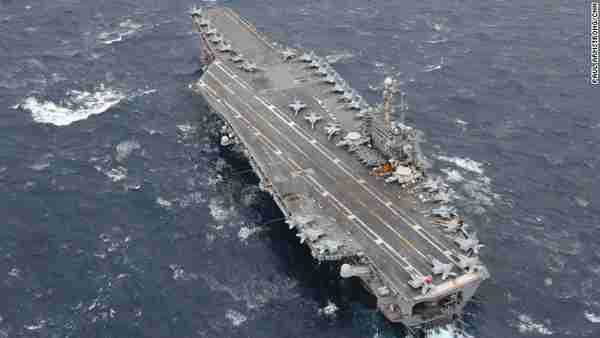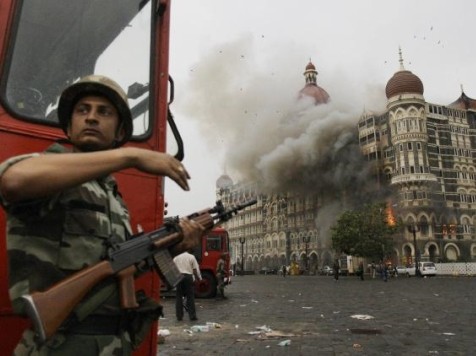
This morning’s key headlines from GenerationalDynamics.com
- India still vulnerable 5 years after ’26/11′ terrorist attack on Mumbai
- China sends jets into air defense zone, after flights by U.S., Japan and S. Korea
- U.S. and Japan conduct huge naval exercise off island of Okinawa
India still vulnerable 5 years after ’26/11′ terrorist attack on Mumbai

November 2008 26/11 attack on the Taj Mahal Palace Hotel in Mumbai
Almost exactly five years ago, on November 26, 2008, ten members ofthe Pakistani jihadist group, Lashkar-e-Toiba (LeT) landed on theMumbai, India, shoreline, having traveled by boat from Karachi inPakistan. What followed was a 60-hour shooting rampage, one of themost horrific terrorist attacks of the decade, killing 164 people.(See “Pakistan-based Lashkar-e-Taiba suspected in terrorist attack on Mumbai (Bombay), India” from 2008.)
Lashkar-e-Toiba (LeT) had taken precautions to prevent the blame forthe attack to traced back to them. The plan was that all theparticipating terrorists would fight to the death, and there would beno claim of responsibility. However, one of the gunmen was capturedby Indian police during the attack (and later hanged), and two LeTleaders were captured by Indians and Americans after the attack,allowing interrogators to get full details about the operationalplanning. Furthermore, America’s signals intelligence capability wasable to find an electronic trail for the attack that led back not onlyto LeT, but also to Pakistan’s Inter-Services Intelligence (ISI)agency. The most likely motive for the attack is now believed to beLeT’s desire to develop closer relations with ISI, at the expense ofother jihadist groups in Pakistan. In the aftermath, India wasconsidering a military attack on LeT on Pakistan’s soil, somethingthat might have led to an India-Pakistan war, but this was headed offby hard intervention on both sides from Secretary of State CondoleezzaRice.
As early as April 5, 2005, Prime Minister Manmohan Singh had said:
“There can be no political compromise with terror. Noinch conceded. No compassion shown… There are no good terroristsand bad terrorists. There is no cause, root or branch, that canever justify the killing of innocent people. No democraticGovernment can tolerate the use of violence against innocentpeople and against the functionaries of a duly establisheddemocratic Government.”
After the 26/11 Mumbai attack, there was a burst of counter-terrorismenergy, but it dropped off quickly. Since then, virtually nothinghas been done to strengthen counter-terrorism efforts.
In the meantime, LeT and its Indian counterpart, Indian Mujahideen(IM) “have enlarged their network and developed capabilities to carryout acts of terror at short notice in various parts of the country…Evidence gathered from various cases indicates Pakistan continues tonurture terrorist groups,” according to Indian police officials.
With the breach in Mumbai 26/11 coming from the sea, there wasenormous rhetorical focus on strengthening coastal security, and muchwas claimed by the government thereafter of measures taken to securethis objective. Five years later, however, it would be necessary toconcede that, fitful efforts notwithstanding, India remains asvulnerable to terrorist attacks along its coastline as it was in 2008.South Asia Terrorism Portal (SATP – India) and ISN Security Watch (Zurich) and Technorati
China sends jets into air defense zone, after flights by U.S., Japan and S. Korea
China sent its Su-30 and J-11 fighter jets on Thursday into itsrecently announced Air Defense Identification Zone (ADIZ), accompaniedby a KJ-2000 airborne radar early warning system. China’s militarysaid it sent the warplanes as a “defensive measure” to patrol the ADIZand the Senkaku/Diaoyu islands. China’s move came hours after Japanand South Korea challenged China’s claim to the ADIZ by sending theirown warplanes into the zone, and that came two days after the U.S. didthe same. These and other countries have refused to recognize theChinese-declared ADIZ.
Chinese officials had initially reacted calmly to the U.S. overflightsby simply acknowledging them and saying the Chinese military hadmonitored them without taking action. But that measured responsequickly ignited fierce criticism by highly nationalistic Chinesebloggers. (See “28-Nov-13 World View — Nationalistic bloggers ridicule China over America’s B-52s”) Pressure from the blogger community apparently forcedthe Beijing government to take more confrontational action.
The danger is that continued confrontations of this type willeventually lead to accidental or intentional combat, especially withnationalism growing in Japan as well as in China. My personal beliefis that China would not want to stumble into a war this way. China isactively preparing for full-scale war with the United States, but theywould want maximum surprise for maximum effectiveness. VOA and CNN
U.S. and Japan conduct huge naval exercise off island of Okinawa

USS George Washington nuclear powered aircraft carrier off Okinawa
USS George Washington nuclear powered aircraft carrier was back incombat mode after its recent detour to the Philippines to take part inthe aid effort in the wake of Super Typhoon Haiyan. It’s patrollingwaters off the island of Okinawa as part of a huge naval exercise –AnnualEx 2013 — involving dozens of warships, submarines and aircraftfrom the U.S. Navy’s 7th fleet and the Japan Maritime Self-DefenseForce (JMSDF). The war games were planned long before China’s ADIZannouncement last week, but the war games will not enter the ADIZregion. However, the increased tension in the East China Sea givesthe annual war games special significance this year. CNN
Permanent web link to this article
Receive daily World View columns by e-mail

COMMENTS
Please let us know if you're having issues with commenting.